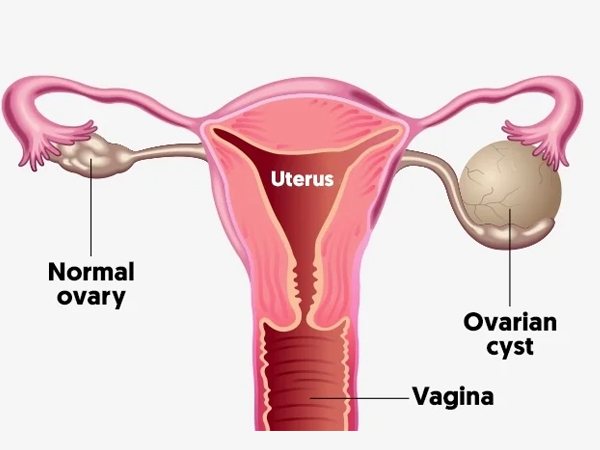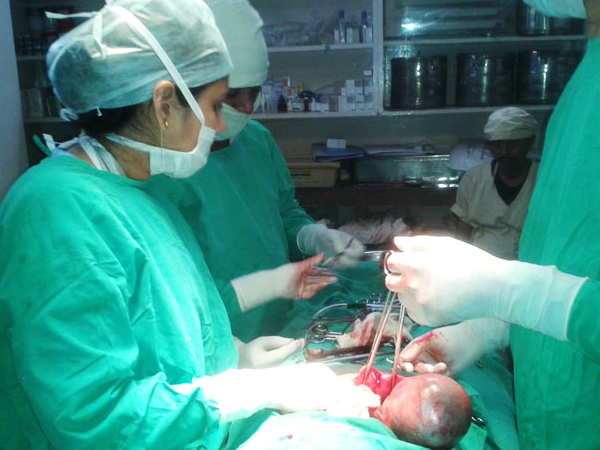Dr. Sudeshna Saha
Lap Surgeon in Kolkata, West Bengal, India
For Appointment Call + 91 98302 45993
Call Between Monday to Saturday 8 A.M. TO 6 P.M.
WhatsApp
+91 98302 45993


For Appointment Call + 91 98302 45993
Call Between Monday to Saturday 8 A.M. TO 6 P.M.
WhatsApp
+91 98302 45993



Ovarian Cysts Definition and Facts
1) Ovarian cysts are closed, sac-like structures within the ovary that are filled with a liquid or semisolid substance.
2) Ovarian cysts may not cause signs or symptoms. Larger cysts are more likely to cause signs and symptoms such as:
i) Pain in the abdomen, pelvis, sometimes radiating to the low back, is the most common symptom
ii) Feeling of bloating or indigestion
iii) Increased abdominal girth
iv) Feeling an urge to have a bowel movement or having difficult, painful bowel movements
v) Pain during sexual intercourse (dyspareunia)
vi) Pain in the lower right or left quadrant of the abdomen on one side
vii) Nausea and vomiting
3) There are many causes and types of ovarian cysts, for example, follicular cysts, "chocolate cysts," dermoid cysts, and cysts due to polycystic ovary syndrome (PCOS).
4) Most ovarian cysts are not cancerous.
5) Most ovarian cysts are diagnosed with ultrasound or physical examination. Transvaginal ultrasound is a common way to examine ovarian cysts.
6) The treatment of an ovarian cyst depends upon the cause of the cyst and varies from observation and monitoring to surgical treatment.
7) Rupture of an ovarian cyst is a complication that sometimes produces severe pain and internal bleeding. A ruptured (burst) ovarian cyst usually causes pain on one side that comes on suddenly.

Symptoms
Most cysts don't cause any symptoms and go away on their own. A large ovarian cyst can cause abdominal discomfort. If a large cyst presses on your bladder, you may feel the need to urinate more frequently because bladder capacity is reduced.
The signs and symptoms of ovarian cysts, if present, may include:
i) Pelvic pain - a dull ache that may radiate to your lower back and thighs
ii) Pelvic pain shortly before your period begins or just before it ends
iii) Pelvic pain during intercourse (dyspareunia)
iv) Pain during bowel movements or pressure on your bowels
v) Nausea, vomiting or breast tenderness like that experienced during pregnancy
vi) Fullness or heaviness in your abdomen
vii) Pressure on your bladder that causes you to urinate more frequently or have difficulty emptying your bladder completely
When to see a doctor
Seek immediate medical attention if you have:
i) Sudden, severe abdominal or pelvic pain
ii) Pain accompanied by fever or vomiting
These signs and symptoms - or those of shock, such as cold, clammy skin; rapid breathing; and lightheadedness or weakness - indicate an emergency and mean that you need to see a doctor right away.
Causes
Most ovarian cysts develop as a result of the normal function of your menstrual cycle. These are known as functional cysts. Other types of cysts are much less common.
Your ovaries normally grow cyst-like structures called follicles each month. Follicles produce the hormones estrogen and progesterone and release an egg when you ovulate. Sometimes a normal monthly follicle keeps growing. When that happens, it is known as a functional cyst. There are two types of functional cysts:
FOLLICULAR CYST Around the midpoint of your menstrual cycle, an egg bursts out of its follicle and travels down the fallopian tube in search of sperm and fertilization. A follicular cyst begins when something goes wrong and the follicle doesn't rupture or release its egg. Instead it grows and turns into a cyst.
CORPUS LUTEUM CYST When a follicle releases its egg, the ruptured follicle begins producing large quantities of estrogen and progesterone for conception. This follicle is now called the corpus luteum. Sometimes, however, the escape opening of the egg seals off and fluid accumulates inside the follicle, causing the corpus luteum to expand into a cyst.
The fertility drug clomiphene (Clomid, Serophene), which is used to induce ovulation, increases the risk of a corpus luteum cyst developing after ovulation. These cysts don't prevent or threaten a resulting pregnancy.
Functional cysts are usually harmless, rarely cause pain, and often disappear on their own within two or three menstrual cycles.
OTHER CYSTS
Some types of cysts are not related to the normal function of your menstrual cycle. These cysts include:
i) Dermoid cysts - These cysts may contain tissue, such as hair, skin or teeth, because they form from cells that produce human eggs. They are rarely cancerous.
ii) Cystadenomas - These cysts develop from ovarian tissue and may be filled with a watery liquid or a mucous material.
iii) Endometriomas - These cysts develop as a result of endometriosis, a condition in which uterine endometrial cells grow outside your uterus. Some of that tissue may attach to your ovary and form a growth.
iv) Dermoid cysts and cystadenomas can become large, causing the ovary to move out of its usual position in the pelvis. This increases the chance of painful twisting of your ovary, called ovarian torsion.

What is an ovarian cyst?
Ovarian cysts are fluid-filled sacs in the ovary. They are common and usually form during ovulation. Ovulation happens when the ovary releases an egg each month. Many women with ovarian cysts don't have symptoms. The cysts are usually harmless.
What are the causes of ovarian cyst?
During a woman's menstrual cycle, an egg grows in a sac called a follicle. This sac is located inside the ovaries. In most cases, this follicle or sac breaks open and releases an egg. But if the follicle doesn't break open, the fluid inside the follicle can form a cyst on the ovary.
How did I get a cyst on my ovary?
There are two main types of ovarian cysts: Functional ovarian cysts - the most common type. These harmless cysts form part of the female's normal menstrual cycle and are short-lived. Pathological cysts - these are cysts than grow in the ovaries; they may be harmless (benign) or cancerous (malignant).

What is ovarian tumor?
Epithelial cell tumors start from the cells on the surface of the ovaries. These are the most common type of ovarian tumors. Germ cell tumors start in the cells that produce the eggs. They can either be benign or cancerous. Most are benign.
Complications
Some women develop less common types of cysts that may not produce symptoms, but that a doctor may find during a pelvic exam. Cystic ovarian masses that develop after menopause may be cancerous (malignant). That's why it's important to have regular pelvic exams.
Infrequent complications associated with ovarian cysts include:
Ovarian torsion Cysts that become large may cause the ovary to move out of its usual position in the pelvis. This increases the chance of painful twisting of your ovary, called ovarian torsion.
Rupture A cyst that ruptures may cause severe pain and lead to internal bleeding.